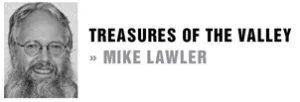It is my ultimate frustration as a local historian to have such a wealth of information on our last two centuries in CV, yet have almost nothing on the thousands of years of human history before that. Our first inhabitants, the Tongva Indians, hunted, camped, established villages, lived entire lives of tragedy and triumph, right here where we have our homes, on Briggs Terrace, in Sparr Heights, and Verdugo City. They had a strong central village, Wikangna (wi-kong-na) somewhere along the base of the Verdugo Mountains, probably where the Verdugo Hills Golf Course is today. The trail between the neighboring villages of Tujungna (Big Tujunga Canyon) and Hahamongna (where JPL is) followed the routes of Honolulu Ave. and Tujunga Canyon Blvd. They gathered acorns in the dense oak forests of CV Park, and in summer retreated to the cool forested canyons of the San Gabriels, Cooks, Dunsmore and Pickens Canyons. They were wealthy among the Indians, living in a veritable supermarket of food sources, and successfully acting as middlemen in the soapstone trade between the Channel Islands and the Western states. Trading parties from Wikangna headed up the Arroyo Seco, meeting other trade trails at Red Box Saddle near Mt. Wilson, and traversing the San Gabriels, and out into the Mojave. Then came the Missions, and the local Tongva were divided between San Gabriel and San Fernando Missions, and their history and culture suppressed. Any traces of them in our valley have been erased by our cycles of fire and flood, or by development.
Windows into this past have opened and closed again over the years, such as the Southwest Museum, now closed. Scattered factions of the Tongva Tribe have kept pieces of their culture alive across LA, though nothing locally.
But a new window has opened, no, a door, to the history of our Indians, literally within sight of the Crescenta Valley. In the last ten years a partnership has developed between the Angeles National Forest Service, and Ne’ayu (“friends” in the Tongva language) to promote Native American Culture. The Forest Service offered them the abandoned Red Box Fire Station, fatefully located there where the trade route trails came together in the mountains above us, and the Haramokngna American Indian Cultural Center was born. In the last several years Haramokngna (ha-ra-mok-na “the place where people gather”) has created a museum and art gallery, a strong program of outreach to local schools, and a solid schedule of Indian craft seminars and Native music festivals. In classes there I have learned to carve soapstone and weave baskets, and have feasted on prickly pear cactus, yucca flowers, venison and elderberry tea.
Haramokngna miraculously survived the Station Fire, and sits in an oasis of unburned forest at the intersection of Angeles Crest Highway and Mt. Wilson Road. They re-open this Saturday in an all-day festival, and they invite us as their nearest neighbors to join them for hands-on craft classes, Native foods (including fry bread!), and music. There’ll be vendor booths selling Indian jewelry, art and books, and info on the recovery of the forest.
I urge you to take a drive up there Saturday and check it out. The drive up there is an amazing journey in itself. The fire has created a vision of contrasts – wildflowers push up through charred branches – dead forests stand on carpets of bright green new growth. As you know Angeles Crest Highway is still closed, so you must take a side route in, which takes you through the heart of the burn area. Take Big Tujunga Canyon to Angeles Forest Highway and turn left toward Palmdale. After a couple miles, turn right on Upper Big Tujunga Canyon, which takes you all the way across to good old Angeles Crest Highway. Turn right and backtrack to Mt Wilson Road, where you’ll find Haramokngna among the last remaining stands of unburned forest. It’s a drive that will awe you.
This Saturday is your chance to rediscover two things we thought we’d lost. The mountains, and our Indian history, are rising renewed from the ashes.
Mike Lawler is the president of the Historical Society of the
Crescenta Valley. Reach him at lawlerdad@yahoo.com

